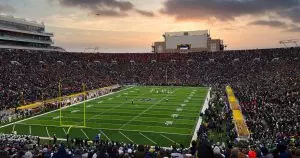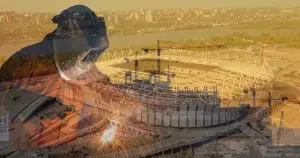Upon initial examination, the realms of sports and real estate may seem distinct, each governed by its own set of rules and goals. However, a closer exploration reveals a compelling and intricate connection that extends beyond the surface. This complex interplay between sports and real estate is characterized by economic, social, and cultural factors, resulting in a symbiotic relationship that has a transformative impact on landscapes and communities.

A notable effect of sports on real estate is its economic influence. Major sporting events, such as the Olympics, World Cup, or regular-season games, can inject significant financial stimulus into local economies. The influx of tourists, athletes, and spectators leads to increased demand for accommodations, dining, and entertainment facilities, subsequently driving heightened activity in real estate markets. Host cities often witness a surge in real estate development as they seek to capitalize on the economic opportunities presented by these sporting spectacles.
In addition to the immediate economic boost, sports also play a vital role in shaping community identities and fostering a sense of pride and belonging. A successful sports team can serve as a focal point for a city or region, attracting residents and businesses. The presence of a thriving sports culture can enhance the perceived desirability of a location, influencing property values and attracting new residents. Real estate developers recognize the value of proximity to sports arenas and stadiums, strategically incorporating them into urban planning to create vibrant, sports-centric neighborhoods that appeal to a diverse range of potential buyers.
The synergy between sports and real estate extends to the realm of commercial development. Sports events serve as magnets for retail and entertainment establishments, leading to the construction of shopping districts, restaurants, and entertainment venues near sports arenas. The lively atmosphere on game days adds an extra layer of appeal to these areas, resulting in increased demand and higher property values for real estate projects located near sports and entertainment hubs.
The influence of sports on real estate is not confined to physical spaces alone. The emergence of virtual sports and esports has introduced a new dimension to this relationship. Esports arenas and gaming centers are becoming significant players in the real estate market, catering to the growing demand for spaces that support competitive gaming and entertainment. As esports gains mainstream popularity, real estate developers are exploring innovative ways to integrate these digital spaces into their projects, acknowledging the evolving preferences and lifestyles of the younger demographic.
The connection between sports and real estate is a dynamic and multifaceted relationship that surpasses the boundaries of their respective domains. The economic impact of major sporting events, the role of sports in community identity, and the integration of sports-centric developments into urban planning all contribute to a transformative connection that shapes the real estate landscape. As both industries continue to evolve, their interdependence is likely to deepen, presenting new opportunities and challenges for stakeholders in the ever-changing world of sports and real estate.
Economic Impact of Sports on Real Estate
The economic influence of sports on real estate is a significant aspect of their interconnected relationship. Major sporting events, such as the Olympics, FIFA World Cup, and other large-scale tournaments, have a substantial impact on the economic landscape of host cities. The influx of tourists, athletes, and spectators generates a palpable buzz and catalyzes a surge in economic activity.
The heightened demand for accommodation is a primary driver of this economic upswing. With thousands of visitors coming to the host city, there is an urgent need for hotels, resorts, and other hospitality infrastructure. Real estate developers respond to this demand by undertaking ambitious projects to construct new accommodations or expand existing ones. This surge in construction activity not only caters to the immediate needs of the sporting event but also has a lasting impact on the sports cal real estate market.

As hotels and resorts multiply to meet the spike in demand, the overall real estate market experiences a ripple effect. Property values in proximity to the event venue often witness a notable increase, driven by the perceived desirability of being close to the sporting action. Homeowners and property investors in these areas find themselves in a favorable position, enjoying the benefits of elevated property values and increased equity.
Rental markets also feel the impact of the sports-induced economic boost. With a growing number of visitors seeking short-term accommodation, rental rates in the vicinity of the event venue tend to escalate. This presents an attractive opportunity for property owners and investors to capitalize on the temporary surge in demand, potentially yielding higher rental incomes during the duration of the sporting event.
The economic impact extends beyond the immediate vicinity of the event. The host city becomes a focal point for increased economic activity. Local businesses, from restaurants to retail outlets, experience a surge in customers as spectators and tourists explore the city during their stay. This economic windfall contributes to the overall prosperity of the region, leaving a lasting legacy that extends beyond the confines of the sporting event.
The economic impact of sports on real estate creates a symbiotic relationship that benefits both industries. While the sporting event receives the necessary infrastructure to host participants and spectators, the real estate market reaps the rewards of increased property values, rental rates, and overall economic vitality. This dynamic interplay underscores the multifaceted nature of the connection between sports and real estate, demonstrating how the excitement of athletic competition can resonate far beyond the confines of the playing field.
Infrastructure Development
The close connection between sports and real estate goes beyond economics to include a crucial element: infrastructure development. Hosting major sporting events often requires significant improvements in infrastructure, such as building or upgrading stadiums, enhancing transportation networks, and improving recreational facilities. This infrastructure development not only meets the immediate needs of the sporting events but also has a lasting impact on sports on the real estate landscape.
Stadiums are a key focus of these infrastructure projects. The demand for modern facilities to host international or high-profile events leads cities to invest in constructing or renovating sports arenas. These projects not only become iconic landmarks but also contribute to the urban development of the surrounding areas. Modern, well-equipped stadiums can elevate the overall appeal of a neighborhood, making it more attractive for residents and businesses.

Transportation networks also undergo significant upgrades to accommodate the influx of spectators and participants during sporting events. Improved roadways, public transit systems, and parking facilities not only ease the logistical challenges but also enhance the overall accessibility of the host city. This improved connectivity can transform real estate in surrounding neighborhoods, making areas with upgraded transportation infrastructure more desirable for residents and businesses, leading to increased property values and sustained real estate growth in the long term.
Recreational facilities, such as parks and green spaces, also receive attention as part of the broader infrastructure development linked to sports events. Cities recognize the importance of providing attractive and well-maintained spaces. The creation or improvement of these recreational amenities enhances the overall livability of a region, contributing to the quality of life for its inhabitants. Real estate markets near these green spaces can experience heightened demand, as residents seek the benefits of a healthier and more enjoyable living environment.
The enduring impact of infrastructure development on real estate is highlighted by the fact that these improvements outlast the duration of the sporting event. Once the games have concluded, the host city is left with a legacy of enhanced facilities and upgraded infrastructure, which continues to attract businesses and residents, fostering sustained real estate growth and urban development.
The interplay between sports and real estate extends to the vital realm of infrastructure development. As cities invest in modern stadiums, improved transportation networks, and enhanced recreational facilities, the local real estate market stands to benefit from increased desirability, property values, and long-term growth. This multifaceted relationship demonstrates how the excitement of sports can catalyze transformative changes extending far beyond the confines of the playing field.
Community Engagement and Identity
The profound impact of sports on real estate extends beyond economics and infrastructure. An equally compelling aspect of this relationship is community engagement and identity. Sports have a unique ability to unite communities, fostering a shared sense of pride and identity that goes beyond the playing field. Successful sports teams become symbols of community pride and unity, resonating deeply with residents and shaping the character of a neighborhood or city. This shared passion for sports becomes ingrained in the fabric of the community, influencing its perception and desirability in the real estate market.
The positive image associated with sporting success often leads to increased desirability for the area among potential residents and businesses. Communities with a vibrant sports culture tend to attract individuals seeking to be part of a lively environment. As a result, the real estate market in these areas experiences heightened demand, with people eager to invest in properties that offer not only physical amenities but also a sense of belonging to a dynamic and successful community.

Neighborhoods rally around their local sports teams, creating a spirit of camaraderie that permeates local businesses, schools, and social gatherings. Real estate developers recognize the draw of being part of a community that rallies together in support of their teams, strategically positioning developments near sports arenas and stadiums, making these areas highly sought-after addresses.
The connection between community engagement through sports and real estate is reciprocal. While successful sports teams contribute to the identity and vibrancy of a community, the resulting positive image enhances the value of real estate in the area. The demand for properties within these communities is driven not only by physical attributes but also by the intangible allure of being part of a place with a strong sense of collective identity.
The interplay of sports in real estate is deeply rooted in the social fabric of communities. Sports have the power to unite people, create a sense of shared identity, and elevate the overall perception of a city or neighborhood. This communal spirit becomes a driving force in the real estate market, as individuals seek to invest in properties that offer not just a place to live but an opportunity to be part of a vibrant and thriving community associated with sporting success.
Residential Preferences
The impact of sports on real estate is profound, influencing the residential preferences of homebuyers and renters in significant ways. The proximity of properties to sports amenities and events plays a crucial role in the valuation and desirability of real estate, reflecting the impact of sports on real estate and the lifestyle preferences of individuals.
Properties located near sports facilities, parks, and recreational areas often command higher prices in the real estate market. The immediate access to these amenities contributes to the perceived value of a property. Living near sports venues or green spaces offers lifestyle benefits, fostering community engagement and well-being. The appeal of being able to attend sporting events or engage in recreational activities without extensive travel enhances the attractiveness of such properties.
In addition to convenience, the presence of sports facilities in a community can significantly influence the demographic that chooses to reside in a particular area. Communities with well-maintained sports amenities tend to attract individuals with a health-conscious mindset. The active and sports-oriented lifestyle becomes a driving factor for individuals seeking to establish their homes in these areas, shaping the real estate landscape beyond just the physical attributes of the properties.

Real estate developers are keenly aware of the impact of sports on real estate especially on amenities on residential preferences and often strategically integrate them into their projects. The inclusion of parks, fitness centers, and recreational spaces becomes a selling point for new developments, appealing to a demographic that prioritizes an active and health-oriented lifestyle. This intentional incorporation of sports-related features into residential projects reflects the recognition that these amenities contribute not only to the immediate enjoyment of residents but also to the long-term value and appeal of the properties.
The influence of sports on residential preferences extends to the broader community atmosphere. Neighborhoods with a strong sports culture tend to foster a sense of camaraderie among residents. The shared passion for sports becomes a bonding element, creating a community spirit that contributes to the overall appeal of the community, influencing the residential choices of those seeking a vibrant and socially connected living environment.
The influence of sports on real estate is intricately linked to the residential preferences of homebuyers and renters. Properties near sports facilities and recreational areas often hold higher value due to the convenience and lifestyle benefits they offer. The influence of sports on the demographics attracted to certain communities shapes the real estate landscape, as health-conscious individuals seek out areas that align with their active and sports-oriented lifestyles. The integration of sports amenities into residential developments emphasizes the recognition of the symbiotic relationship between sports and real estate, creating communities that cater to the preferences and well-being of their residents.
Corporate Sponsorship and Development
The convergence of sports on real estate takes on a corporate dimension through the avenue of corporate sponsorship and development. As corporations increasingly recognize the value of associating their brand with sports, these partnerships extend beyond mere logo placements to substantial investments in real estate projects. One prominent manifestation of this collaboration is the acquisition of stadium naming rights, forging dynamic alliances between sports organizations and real estate developers.
Stadium naming rights, a key facet of sports sponsorship, often result in significant financial commitments from corporations eager to align their brand with the prestige and visibility of major sports venues. This infusion of corporate capital not only supports the sports organizations but also catalyzes synergistic developments in the surrounding real estate.

Real estate developers leverage these partnerships to create mixed-use developments, capitalizing on the inherent connections between sports, entertainment, and the built environment. The result is a harmonious blend of commercial, residential, and entertainment spaces designed to complement and enhance the overall experience of attending sports events.
Mixed-use developments arising from corporate-sponsored sports ventures go beyond the traditional model of standalone stadiums or arenas. They transform the surrounding areas into vibrant hubs, offering a diverse range of amenities and services. This intentional integration of various functions caters to a broad audience, attracting residents, businesses, and visitors alike.
The collaborative efforts between sports organizations and real estate developers often lead to the creation of entertainment districts or precincts. These districts, strategically positioned around sports venues, become focal points for leisure, commerce, and community engagement. The infusion of corporate sponsorship not only facilitates the development of these districts but also ensures ongoing support for their maintenance and enhancement.
The influence of corporate sponsorship extends to the design and architecture of these mixed-use developments. With an eye on creating iconic landmarks, corporations seek to leave a lasting imprint on the urban landscape. The resulting architectural innovations and state-of-the-art designs contribute not only to the aesthetic appeal of the area but also to its overall economic and cultural significance.
The synergy between sports and real estate, fueled by corporate sponsorship, underscores the transformative potential of these collaborations. As corporations invest in the naming rights of stadiums, they actively participate in shaping the urban fabric, fostering economic growth, and enhancing community experiences. The resulting mixed-use developments stand as tangible representations of the dynamic interplay between sports, corporate partnerships, and the ever-evolving landscape of real estate.
The infusion of corporate sponsorship into sports organizations opens up exciting avenues for real estate development. Stadium naming rights, in particular, serve as catalysts for collaborations between sports and real estate, giving rise to mixed-use developments that seamlessly blend commercial, residential, and entertainment spaces. These ventures not only reflect the commitment of corporations to align their brand with sports but also contribute to the creation of vibrant and multifaceted urban environments that leave a lasting impact on the communities they serve.
In conclusion, the connection between sports and real estate is intricate and mutually beneficial, with each impacting and fostering the advancement of the other. Sports has a broad influence on real estate, encompassing economic growth, infrastructure enhancement, community involvement, and residential preferences. As more cities and communities acknowledge the role of sports in driving progress, the fusion of these two industries is expected to gain further prominence in the years ahead. The successful intertwining of sports and real estate demonstrates how these unrelated domains can collaborate to form flourishing and lively urban environments.







